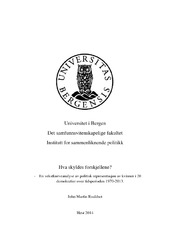Hva skyldes forskjellene? En vekstkurveanalyse av politisk representasjon av kvinner i 20 demokratier over tidsperioden 1970-2013.
Master thesis
Permanent lenke
https://hdl.handle.net/1956/9123Utgivelsesdato
2014-11-19Metadata
Vis full innførselSamlinger
Sammendrag
The percentage of women in national parliaments varies substantially between countries and over time. This study examines formal political representation of women in 20 western democracies from 1970 to 2013. The explanatory value of institutional, sosioeconomical and cultural factors on the percentage of women in national parliaments are examined by quantitative analysis of country-level data. A battery of growth-curve models are utilized to account for intra-country change over time as well as differences between countries. Consistent with previous studies, the growth-curve analysis finds a negative effect of majoritarian electoral systems. Gender quotas, introduced by law or voluntarily by political parties, are found to have a positive effect. This finding contradicts some previous studies, and underlines the importance of a longitudinal approach when examining the percentage of women in national parliaments. Sosioeconomic factors are found to have conditional effects on the percentage of women in parliments. The percentage of women in paid labor is found to have a positive effect only in the Nordic region, while the percentage of women who enroll to higher education only have a positive effect in countries with proportional electoral systems. Findings of conditional effect of female labor force participation warrents further study. The problem of quantifying cultural factors in a satisfying manner persists for this longitudinal study. Catholic religious dominance is found not to have explanatory value once regional differences are controlled for. Previous studies have consistently found positive effects of Nordic countries when controlling for regions. In this study however, no statistically significant effect of Nordic countries compared to English-speaking countries is found once institutional and sosioeconomic factors are controlled for. Instead, the Continental European region is distinguished by a negative effect on the pecentage of women in national parliaments. These findings contributes to understanding the dynamics of political representation of women both by reinforcing and challenging previous findings.
